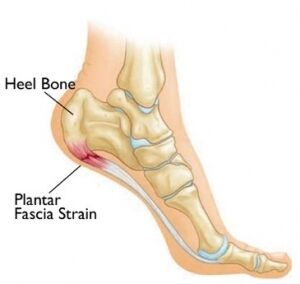Case Study: Heel Pain in 11 Year-Old Girl – Plantar Fasciitis or Sever’s Disease?
Presentation: Plantar Fasciitis or Sever’s Disease?
An 11 year old girl presented at the Sydney Heel Pain Clinic complaining of heel pain in the bottom of her left foot of approximately 6 months. Her mother had previously taken her to the family’s GP, who suggested that it was likely to be Sever’s disease causing the problem and she was probably too young to have plantar fasciitis, but that further investigations would be required to make a correct diagnosis. The GP suggested that a specialist sports podiatrist should be consulted for the most accurate diagnosis.

The girl was a competitive tennis player, training 3 times a week and competing on weekends, in addition to her regular physical activity sessions at school.
Patient’s Pain Symptoms: Plantar Fasciitis or Sever’s Disease?
The patient reported some pain symptoms that were indicative of plantar fasciitis. She reported that the heel pain was only in the left foot. She had sharp pain in the mornings when she stepped out of bed. When exercising, the girl’s pain was present during her warm ups but then subsided, before becoming very painful again when she finished exercising.
Examination and Assessment: Plantar Fasciitis or Sever’s Disease?
Whilst some of the girl’s symptoms were consistent with a diagnosis of plantar fasciitis, Sever’s disease would still need to be ruled out. Sever’s disease is a common cause of heel pain in children between 7 and 14 years of age who are physically active. The sports podiatrist carried out a thorough examination, beginning with a comprehensive history-taking. The patient’s feet were examined and palpated; the painful left foot was compared with the normal right foot. The sports podiatrist also assessed the girl’s range of motion and strength in the foot and ankle joint, and the flexibility of her lower leg and foot muscles, ligaments and tendons.
Biomechanical Assessment for Plantar Fasciitis
The sports podiatrist conducted a biomechanical assessment and gait analysis as part of his diagnostic process in determining whether plantar fasciitis was causing this patient’s heel pain. The biomechanical assessment was conducted by placing markers on the patient’s lower legs and recording footage of her walking on the treadmill. The footage was reviewed in slow motion and analysed to detect functional abnormalities and malalignments. Arch height and heel angle were also measured.
Significant Findings of the Examination for Plantar Fasciitis or Sever’s disease
- The patient felt a lot of pain when the sports podiatrist applied pressure to the plantar aspect of the heel (the area where the plantar fascia ligament connects to the heel bone)
- There was no pain response when the sports podiatrist squeezed the back of the patient’s heel on the painful foot (growth plate)
- The patient had tight calf muscles, restricting range of motion in the ankle
- The patient demonstrated calcaneal eversion, causing over pronation in both feet as she walked.
Diagnosis Confirmed: Plantar Fasciitis
The sports podiatrist informed the patient and her mother that she had plantar fasciitis: a condition that occurs with overuse and persistent strain placed on the plantar fascia ligament. The sports podiatrist said that in his opinion, Sever’s disease could be ruled out due to the absence of pain at the back of the heel (this is the area that is classically sore in cases of Sever’s disease), the fact that the girl reported her pain was not noticeable during physical activity after warming up, and the absence of any swelling or redness.
Treatment for Plantar Fasciitis
Since the patient’s plantar fasciitis diagnosis was confirmed, a treatment plan could be devised and commenced. The sports podiatrist assured the girl’s mother that her plantar fasciitis could be resolved. The main goal of the plantar fasciitis treatment plan was to reduce load , inflammation, relieve the patient’s pain, and facilitate healing of the plantar fascia.
The sports podiatrist gave specific recommendations as to which makes and models of shoes would be most appropriate for the patient to wear during her school day and physical activity sessions. Both of the patient’s feet were strapped with rigid sports tape in order to assist with controlling the load, arch height and unloading the plantar fascia, allowing it to heal.
The sports podiatrist demonstrated to the patient and her mother the types of exercises she should perform to help her increase the flexibility in her calf muscles. He advised them that this would reduce the strain on the plantar fascia. The patient was instructed to carry out her stretches three times a day, especially before going to bed at night.
It was recommended that the patient take a break from her regular sporting activities for the next 3 weeks while her undergoing her plantar fasciitis treatment.
Plantar Fasciitis Treatment Outcomes
- The patient returned to the clinic on a weekly basis for the next three weeks to have her feet strapped and review her plantar fasciitis. She reported that with rest and stretching, and the use of her new shoes at school, she was not in as much pain when she got out of bed in the mornings. The sports podiatrist advised that she could begin incorporating one session of physical activity back in to her weekly routine, and if her pain was not significantly worse, the following week she could add another. The patient was reminded of the importance of strapping her feet as instructed, and making sure to do a correct warm up and cool down.
- Please note that this particular case study is unique to this patient. Diagnosis and treatment details are for informational purposes only and should not be taken as general medical advice. If you are suffering with heel pain or you think that you might have plantar fasciitis, you should make an appointment with an appropriately qualified sports podiatrist in order to obtain an accurate diagnosis and individualised treatment plan.
- Podiatrist – Omar Mohamad
- Sydney Heel Pain Clinic – North Sydney
- 93883322
Written by Karl Lockett


